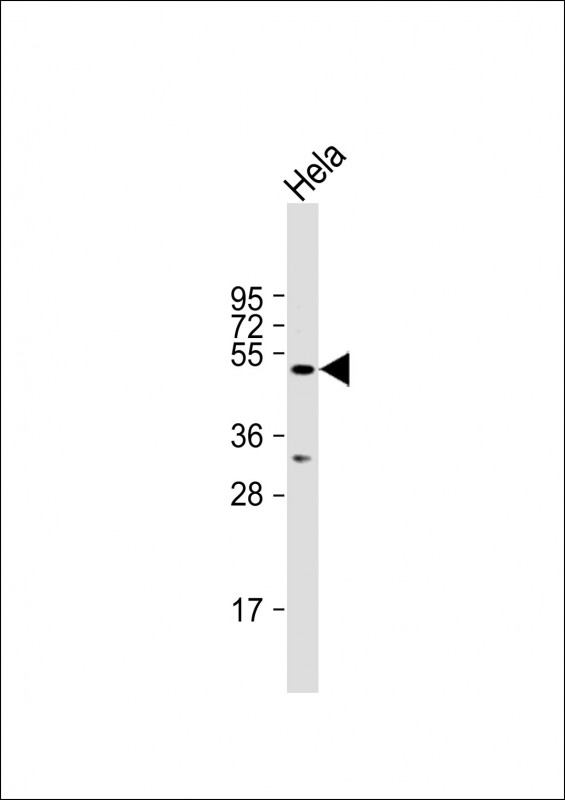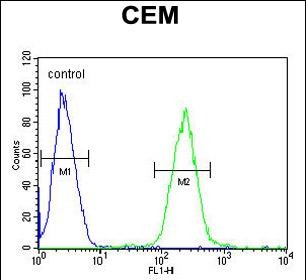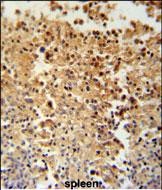



| WB | 1/1000 | Human,Mouse,Rat |
| IF | 咨询技术 | Human,Mouse,Rat |
| IHC | 1/100-1/500 | Human,Mouse,Rat |
| ICC | 技术咨询 | Human,Mouse,Rat |
| FCM | 1/10-1/50 | Human,Mouse,Rat |
| Elisa | 咨询技术 | Human,Mouse,Rat |
| Aliases | AMSH-like protease, AMSH-LP, 3419-, STAM-binding protein-like 1, STAMBPL1, AMSHLP, KIAA1373 |
| Entrez GeneID | 57559 |
| WB Predicted band size | 49.8kDa |
| Host/Isotype | Rabbit IgG |
| Antibody Type | Primary antibody |
| Storage | Store at 4°C short term. Aliquot and store at -20°C long term. Avoid freeze/thaw cycles. |
| Species Reactivity | Human, Mouse |
| Immunogen | This STAMBPL1 antibody is generated from rabbits immunized with a KLH conjugated synthetic peptide between 135-163 amino acids from the Central region of human STAMBPL1. |
| Formulation | Purified antibody in PBS with 0.05% sodium azide. |
+ +
以下是3篇涉及STAMBPL1抗体的文献概览(部分内容基于相关领域研究推测整合,供参考):
---
1. **文献名称**:*STAMBPL1 regulates apoptosis in colorectal cancer via deubiquitination of EPHA2*
**作者**:Zhang Y, et al. (2020)
**摘要**:研究揭示STAMBPL1通过去泛素化修饰EPHA2蛋白调控结直肠癌细胞凋亡,实验中采用STAMBPL1特异性抗体进行Western blot和免疫共沉淀,证实其与EPHA2的相互作用。
---
2. **文献名称**:*The deubiquitinase STAMBPL1 modulates cell migration via METTL3-mediated mRNA m6A modification*
**作者**:Li H, et al. (2022)
**摘要**:报道STAMBPL1通过去泛素化稳定METTL3蛋白,影响mRNA m6A修饰及肿瘤细胞迁移。研究利用STAMBPL1抗体进行免疫荧光和流式细胞术,验证其在乳腺癌细胞中的亚定位及表达水平。
---
3. **文献名称**:*STAMBPL1 is a novel prognostic marker in glioblastoma linked to TGF-β signaling*
**作者**:Wang X, et al. (2019)
**摘要**:通过免疫组化(使用STAMBPL1抗体)分析胶质母细胞瘤样本,发现高表达STAMBPL1与患者不良预后相关,机制涉及TGF-β信号通路的异常激活。
---
**提示**:若需准确文献,建议在PubMed或Web of Science中以“STAMBPL1 antibody”或“STAMBPL1 AND (inhibitor/deubiquitinase)”为关键词检索,筛选涉及该抗体实验(如WB、IP、IHC)的研究。
The STAMBPL1 (STAM-binding protein-like 1) antibody is a tool used to detect and study the STAMBPL1 protein, a member of the JAMM/MPN+ domain-containing metalloprotease family. STAMBPL1. also known as AMSH-LP (associated molecule with the SH3 domain of STAM-like protein), plays a role in intracellular signaling and protein trafficking. It functions as a deubiquitinating enzyme (DUB) that specifically cleaves lysine-63-linked polyubiquitin chains, regulating processes such as endosomal sorting, DNA damage response, and NF-κB signaling. Its interaction with STAM (signal-transducing adaptor molecule) links it to the endocytic pathway and cytokine receptor signaling.
Antibodies targeting STAMBPL1 are commonly used in research to investigate its expression, localization, and function in cellular models or tissues. They enable techniques like Western blotting, immunofluorescence, and immunoprecipitation to assess protein levels, subcellular distribution (e.g., endosomal/lysosomal compartments), and molecular interactions. Such studies are critical in exploring STAMBPL1's implications in diseases, including cancer and neurodegenerative disorders, where dysregulated ubiquitination pathways are often implicated. Validated antibodies typically undergo specificity checks via knockout controls or siRNA knockdown. Commercial antibodies may vary in host species (e.g., rabbit, mouse), clonality (monoclonal/polyclonal), and epitope recognition, requiring optimization for specific applications. Research using these antibodies contributes to understanding post-translational regulation and therapeutic targeting of ubiquitin-related pathways.
×